Caution: Unless directed otherwise, the ignition and start switch must be in the OFF or LOCK position, and all electrical loads must be OFF before servicing
any electrical component. Disconnect the negative battery cable to prevent an electrical spark should a tool or equipment come in contact with an exposed electrical terminal. Failure to follow these precautions may result in personal injury and/or damage to
the vehicle or its components.

- Disconnect
the negative battery cable.
- Raise the vehicle and support. Refer to
Lifting and Jacking the Vehicle
in General Information.
- Drain the coolant. Refer to
Cooling System Draining and Filling
in Engine Cooling.
- Lower the vehicle.
- Recover the air conditioning system refrigerant. Refer to
Refrigerant Recovery and Recharging
in Heating, Ventilation
and Air Conditioning.

- Disconnect
the intake air temperature sensor (IAT) connector.
- Disconnect the mass air flow (MAS) sensor connector.

- Reposition
the air intake duct and the air cleaner assembly forward.
- Remove the upper radiator support .
- Remove the radiator. Refer to
Radiator Replacement
in Engine Cooling.
- Remove the Electronic Brake Control Module/Break Pressure Modulator Valve
(EBTCM/BPMV) and bracket. Refer to
Brake Pressure Modulator Valve Bracket Replacement
in Antilock Brake System.
- Reposition the brake pipes.

- Remove
the accessory drive belt (5).
Important: Cap the fittings and plug the holes when
separating fuel system components this prevents fuel, dirt and other contaminants
from entering the fuel system.

- Remove the fuel line from the
connector at front of the dash.
- Remove the fuel rail covers.
- Relieve the fuel system pressure using the J 34730-1A
. Refer to
Fuel Pressure Relief
in Engine Controls - 5.7 L.

- Disconnect
the fuel line at the fuel rail (1).
Important: Cap the hoses and inlets when separating
the cooling system components, this prevents dirt and other contaminants from entering
the cooling system.

- Disconnect
the radiator hoses from the water pump.

- Disconnect the heater hoses from the water pump.

- Disconnect
the following electrical connectors from the top of the engine:
| • | The ignition coil main harness connectors |
| • | The evaporative emission (EVAP) solenoid |
| • | The electric throttle motor |
| • | The throttle position sensor (TPS) |
| • | The engine coolant temperature (ECT) sensor |
| • | The air conditioning compressor |

- Disconnect
the generator electrical connectors.

- Remove the generator. Refer
to
Generator Replacement
in
Engine Electrical.

- Disconnect the brake booster
vacuum hose from the brake booster.

- Remove the intermediate shaft to steering gear bolt.
- Disconnect the intermediate steering shaft from the steering gear and
position it to the left onto the frame rail.

- Disconnect
the secondary air injection (AIR) hose from the left exhaust manifold.
Important: Do not remove the engine flywheel housing
to driveline support assembly bolts until it is called out in the procedure.
- Raise and suitably support the vehicle.
- Remove both of the front tire and wheel assemblies. Refer to
Tire and Wheel Removal and Installation
in Tires and
Wheels.
- Disconnect and unclip the heated oxygen sensors (HO2S) connectors from
the intermediate exhaust pipes.
- Remove the intermediate exhaust pipes. Refer to
Intermediate Pipe Replacement
in Engine Exhaust.

- Remove the close-out panel bolts.
- Remove the close-out panel.

- Remove the positive cables from the starter.
- Remove the (S) cable from the starter.

- Remove the starter bolts.
- Remove the starter from the vehicle.
- Remove all wiring harness clips from the right side and rear of the engine
block.

- Disconnect
the oil level sensor electrical connector.
- Disconnect the crank position sensor electrical connector.
- Disconnect the right heated oxygen sensor (HO2S) electrical connector.

- Remove
the air conditioning (AC) compressor hose assembly retaining bolt.
- Remove the air conditioning compressor hose assembly from the AC compressor.

- Disconnect
the engine oil temperature sensor electrical connector.
- Disconnect the left HO2S electrical connector.

- Remove
the front stabilizer shaft. Refer to
Stabilizer Shaft Replacement
in Front Suspension.

- Disconnect
the electrical connectors and harness from the electric cooling fans.

- Remove
the electric cooling fan assembly by sliding the whole unit upwards.

- Loosen the tie rod end nuts (3).
- Seperate the tie rod ends (5) from steering knuckles (4) using J 42188
.
- Disconnect the antilock brake system (ABS) electrical connector clips
from the crossmember (if equipped).
- Disconnect the electronic variable orifice control (EVO) connector clips
from the crossmember.
- Disconnect the real time damping (RTD) connector clips from the crossmember
(if equipped).

- Remove
the shock absorber lower mounting bolts.

- Remove the front transverse leaf spring. Refer to
Front Transverse Spring Replacement
in Front Suspension.

- Disconnect
the automatic transmission cooler pipes at the engine flywheel housing junction
(if equipped).
- Disconnect the automatic transmission cooler pipe clamps from the front
and the rear of the engine oil pan (if equipped).

- Disconnect
the automatic transmission cooler pipes from the radiator (if equipped).
Notice: Use the correct fastener in the correct location. Replacement fasteners
must be the correct part number for that application. Fasteners requiring
replacement or fasteners requiring the use of thread locking compound or sealant
are identified in the service procedure. Do not use paints, lubricants, or
corrosion inhibitors on fasteners or fastener joint surfaces unless specified.
These coatings affect fastener torque and joint clamping force and may damage
the fastener. Use the correct tightening sequence and specifications when
installing fasteners in order to avoid damage to parts and systems.
Important: Failure to use the minimum fastener length
specified will prevent proper retention of the propeller shaft during disassembly.
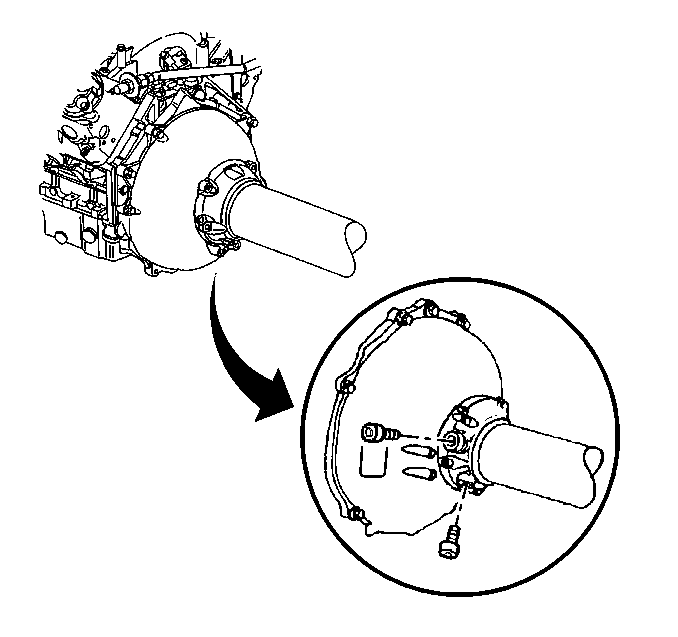
- With automatic transmission vehicles, use
the following steps:
| 58.1. | Remove the two plug bolts in the driveline support assembly. |
| 58.2. | Install a M10.0-1.5 x 55 mm bolt or longer in each plug location. |
Tighten
Tighten the M10 bearing support bolts to 35 N·m
(26 lb ft).

- With
automatic transmission vehicles, remove the engine flywheel housing access plug.
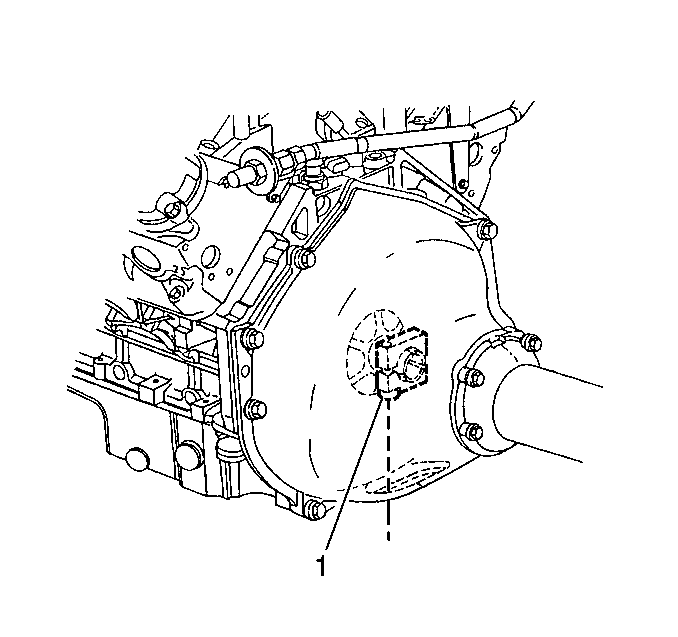
- Orientate the automatic transmission flywheel
hub collar to access the bolt (1).
- Position the collar bolt facing downward.
- Loosen the automatic transmission flywheel hub collar bolt (1).
- Unclip the wiring harness from engine and reposition it to the driveline.

Important: The weight of the engine should never be
supported by J 42203
.
- Install J 42203
to the
close-out panel flange.
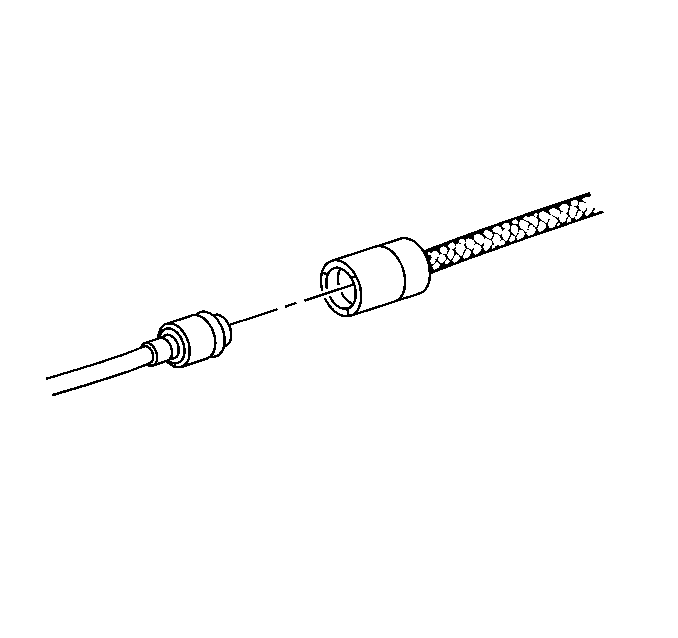
- Vehicles
equipped with a manual transmission need to:
| 65.1. | Unclip the clutch actuator hose from the engine flywheel housing clip. |
| 65.2. | Using J 36221
,
depress the white circular release ring on the actuator hose and simultaneously
pull lightly on the master cylinder hose to disconnect. |
| 65.3. | Protect both ends from dirt and damage. |
| 65.4. | Remove the engine flywheel housing bolts from the driveline support assembly. |

Important: The weight of the engine should never be
supported by J 42203
.
- Install J 42203
to the
close-out panel flange.
- Slowly lower the vehicle to the J 39580
and J 39580-500
.
- Support the engine and crossmember assembly on J 39580
and J 39580-500
.
- BY HAND, remove the front and rear crossmember nuts.
- Partially raise the vehicle.
- Remove the AIR tube bracket bolt and reposition the tube bracket to gain
access to the left rear ground strap.
- Remove the ground strap from the rear of left cylinder head.

- Disconnect
the following electrical connectors from the back of the engine:
| • | The engine oil pressure sensor |
| • | The camshaft position sensor |
| • | The manifold absolute pressure (MAP) sensor |
| • | The knock sensor wire harness connector |
| • | All remaining electrical connections |
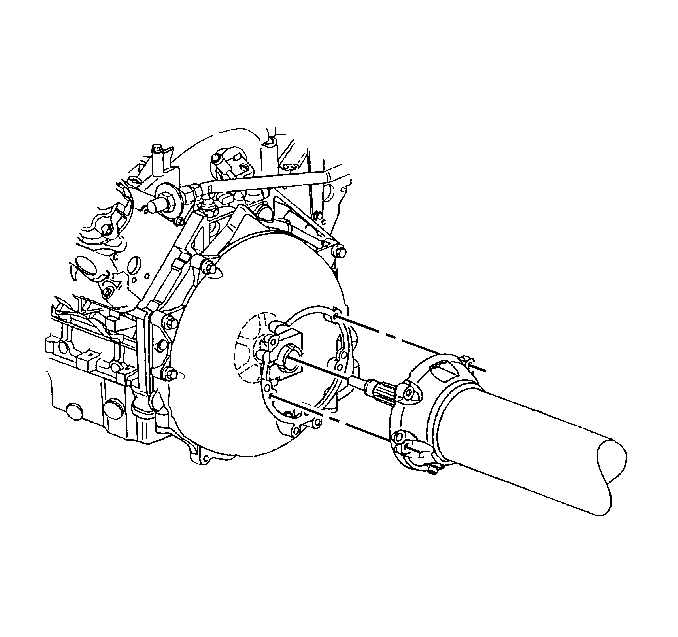
- Remove the front driveline support assembly bolts from the driveline.
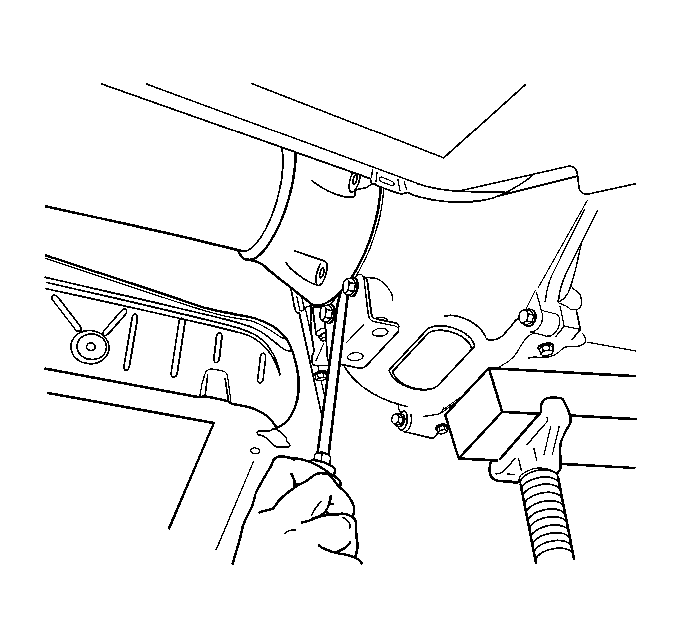
Important: Visually inspect the wiring harness detachment
from the engine.
- Insert a flat bladed screwdriver, or similar tool, between the edge of driveline
support assembly and the engine flywheel housing, then pry the engine
loose from the driveline.
- Slowly pull the engine away from the propeller shaft.
- As soon as the propeller input shaft clears the engine flywheel housing,
slowly raise the vehicle.
- Slide the engine and crossmember assembly forward in order to clear the
propeller shaft spline.
Important: Visually inspect the wiring harness clearances
while raising the vehicle.
- Raise the vehicle completely off of the engine and crossmember assembly.

Important: It is not necessary to open the power steering
system during the engine removal procedure.
- Remove the power steering pump pulley using J 25034-C
.
- Remove the power steering pump bolts.
- Remove the power steering pump and reservoir from the engine and reposition
them to the crossmember.
- Remove the air conditioning (AC) compressor belt.
- Remove the air conditioning compressor bolts and nut. Refer to
Air Conditioning Compressor Replacement
in HVAC.
- Remove the air conditioning compressor stud and compressor from the engine.
- Remove the air conditioning compressor bracket bolt and bracket.
- Remove the AIR tube mounting bolts and tube from the exhaust manifolds.
- Install J 41798
to the engine.
- Install a lifting device to the J 41798
.
- Remove the spark plug wires from the spark plugs.
- Remove the spark plugs from the cylinder heads. Refer to
Spark Plug Replacement
in Engine Electrical.

- Remove the engine mount to crossmember nuts.
- Remove the engine from the crossmember, using J 41798
.
- Install the engine onto an engine stand and remove the J 41798
.
- Prepare the engine for disassembly. Refer to
Engine Balancing
.
The steps in the following procedure are in a specific order. Follow these
steps in this order and ignore no details.
- Prepare the engine for installation. Refer to
Engine Prelubing
and
Engine Balancing
.

- Install J 41798
to the
engine.
- Install a lifting device to the J 41798
.
- Install the engine to the crossmember.
Notice: Use the correct fastener in the correct location. Replacement fasteners
must be the correct part number for that application. Fasteners requiring
replacement or fasteners requiring the use of thread locking compound or sealant
are identified in the service procedure. Do not use paints, lubricants, or
corrosion inhibitors on fasteners or fastener joint surfaces unless specified.
These coatings affect fastener torque and joint clamping force and may damage
the fastener. Use the correct tightening sequence and specifications when
installing fasteners in order to avoid damage to parts and systems.
- Install the crossmember nuts to the engine mount.
Tighten
Tighten the engine mount nuts to 54 N·m
(40 lb ft).
- Install the spark plugs to the cylinder heads. Refer to
Spark Plug Replacement
in Engine Electrical.
- Install the spark plug wires to the spark plugs.
- Install the AIR pipe and mounting bolts to the exhaust manifolds.
Tighten
Tighten the AIR pipe to 20 N·m (15 lb ft).
- Install the AC compressor bracket and bolt to the engine.
Tighten
Tighten the AC compressor bracket bolts to 50 N·m
(37 lb ft).
- Install the AC compressor mounting stud to the engine.
Tighten
Tighten the AC compressor mounting stud to 9 N·m
(80 in ft).
- Install the AC compressor to the AC bracket. Refer to
Air Conditioning Compressor Replacement
in HVAC.
- Install the AC compressor belt. Refer to
Air Conditioning Compressor Belt Replacement
.
- Install the power steering pump and reservoir to the engine.
- Install the power steering pump mounting bolts.
Tighten
Tighten the power steering pump mounting bolts to
25 N·m (18 lb ft).
- Install the power steering pump pulley to the pump using J 25033-C
.

- From the new engine, remove
the generator mounting bolts.
- Remove the generator.
- Remove the generator mounting bracket bolt and bracket.
- Roll the engine and crossmember assembly underneath the vehicle.
- Partially lower the vehicle to the engine and crossmember assembly.
- Install the ground strap to the rear of the left cylinder head.
Tighten
Tighten the ground strap bolt to 32 N·m
(24 lb ft).
- Install the AIR tube bracket bolt and the bracket.

- Route
the electrical harnesses and connect the following electrical connectors at the
rear of the engine:
| • | The engine oil pressure sensor |
| • | The camshaft position sensor |
| • | The knock sensor wire harness connector |
| • | All remaining electrical connections at the rear of the engine |
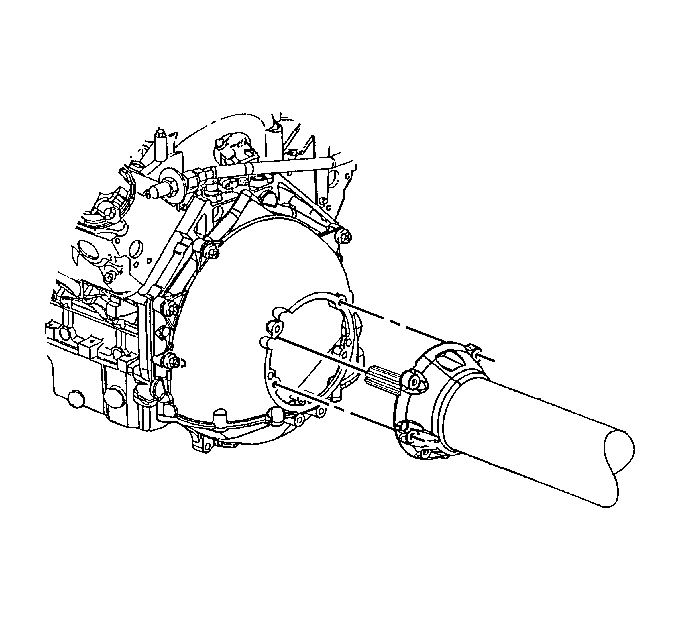
- Vehicles equipped with a manual transmission, slide the engine and crossmember
assembly rearward. Do not force the engine onto the propeller spline.
- Position the engine to the proper height and angle in order to install
the propeller input shaft.
- Insert the propeller input shaft into the clutch driven plate hub while
maintaining the proper angle, Do Not Force. Rotate the shaft slightly
to bring the two splines into alignment, if necessary.

- Slowly
seat the engine flywheel housing to the driveline.
- Install the front driveline support bolts.
Tighten
Tighten the engine flywheel housing to the driveline
support assembly bolts to 50 N·m (37 lb ft).
- Clip the clutch actuator hose to the engine flywheel housing clip.
- Connect the master cylinder hose to the clutch acuator hose.

Important: Do not tighten the flywheel hub collar bolt
at this time.
- Vehicles equipped with an automatic transmission, slide the engine and crossmember
assembly rearward. Do not force the engine onto the propeller spline.
- Position the engine to the proper height and angle in order to install
the propeller input shaft.
- Install the front driveline support bolts.
Tighten
Tighten the engine flywheel housing to the driveline
support assembly bolts to 50 N·m (37 lb ft).
- Hand tighten the flywheel hub collar bolt.
- Install the AIR tube bracket and mounting bolts to the left cylinder
head.
Tighten
Tighten the AIR tube to 50 N·m (37 lb ft).
- Lower the vehicle onto the crossmember and align the dowels.
Important: Use only hand tools when tightening or torquing
crossmember nuts.
- By HAND, install new crossmember nuts.
Tighten
Tighten the crossmember nuts to 110 N·m
(81 lb ft).
- Raise the vehicle.
- Clip the wiring harness to the rear of the engine.
- Remove J 42203
from the vehicle.

- Vehicles equipped with an automatic transmission,
remove the previously installed M10-1.5 x 55mm bolts from the front of
the driveline support assembly.
- Install two plugs in the driveline support assembly.
Tighten
Tighten the plugs to 50 N·m (37 lb ft).

- Connect
the automatic transmission cooler pipes at the engine flywheel housing junction
(if equipped).
Tighten
Tighten the automatic transmission cooler pipes
to 27 N·m (20 lb ft).
- Install the automatic transmission cooler pipe front retaining clamp
bolt, if equipped.
Tighten
Tighten the automatic transmission cooler pipe front
retaining clamp bolt to 12 N·m (106 lb in).
- Install the automatic transmission cooler pipe rear retaining clamp bolt,
if equipped.
Tighten
Tighten the automatic transmission cooler pipe rear
retaining clamp bolt to 2.5 N·m (22 lb in).

- Install the front transverse leaf spring. Refer to
Front Transverse Spring Replacement
in Front Suspension.

- Install
the shock absorber lower mounting bolts.
Tighten
Tighten the shock absorber lower mounting bolts
to 28 N·m (21 lb ft).
- Install the ABS electrical connector clips to the crossmember.
- Install the EVO electrical connector clips to the crossmember.
- Install RTD electrical connector clips to the crossmember (if equipped).

- Remove J 33432-A
from the
spring.
- Install the radiator. Refer to
Radiator Replacement
in Engine Cooling.

- Install
the electric cooling fan assembly to the radiator by sliding the whole unit into
the slots provided.

- Connect
the electrical connectors and harness to the electric cooling fans.

- Install
the front stabilizer shaft to the lower control arms. Refer to
Stabilizer Shaft Replacement
in Front Suspension.
- Install the wiring harness ground wires to the left side of the engine.

- Connect
the left front HO2S sensor connector.
- Connect the engine oil temperature sensor connector.

- Install
the AC compressor hose assembly to the compressor.
- Install the AC compressor line retaining bolt.
Tighten
Tighten the AC compressor hose mounting bolts to
35 N·m (26 lb ft).

- Connect
the right front HO2S sensor connector.
- Connect the crank position sensor connector.
- Connect the oil level sensor connector.
- Install the wiring harness ground wires to the right side of the engine
block.

- Install the starter. Refer to
Starter Motor Replacement
in Engine
Electrical.

- Install the driveline close-out
panel.
- Install the driveline close-out panel bolts.
Tighten
Tighten the close-out panel bolts to 12 N·m
(106 lb in).
- Install the intermediate exhaust pipe and hangers. Refer to
Intermediate Pipe Replacement
in Engine Exhaust.
- Install the HO2S sensors and clip harness.
- Install the front tire and wheel assemblies.
Tighten
Tighten the wheel nuts to 140 N·m (100 lb ft).
- Lower the vehicle.

- Connect
the automatic transmission cooler pipes to the radiator (if equipped). Refer to
Fastener Tightening Specifications
in Automatic
Transmission.

- Connect
the AIR hose to the left exhaust manifold.

- Connect the intermediate steering shaft to the steering gear.
- Install the intermediate steering shaft bolt.
Tighten
Tighten the intermediate steering shaft bolt to
48 N·m (35 lb ft).

- Connect the brake booster vacuum
hose to the brake booster.

- Install the generator mounting
bracket.
- Install the generator mounting bracket bolt.
Tighten
Tighten the generator mounting bracket bolt to 50 N·m
(37 lb ft).
- Install the generator.
- Install the generator mounting bolts.
Tighten
Tighten the generator mounting bolts to 50 N·m
(37 lb ft).

- Connect
the generator electrical connectors.
Tighten
Tighten the nuts to 13 N·m (10 lb ft).

- Connect
the following electrical connectors to the top of the engine:
| • | The ignition coil main connectors |
| • | The electric throttle motor |
| • | The throttle position sensor |

- Connect the heater hoses to the water pump.

- Connect
the radiator hoses to the water pump.

- Connect
the fuel line to the fuel rail (1).

- Install the fuel rail covers.

- Install
the accessory drive belt (5).
- Install the Electronic Brake Control Module/Break Pressure Modulator
Valve (EBTCM/BPMV) and bracket (1). Refer to
Brake Pressure Modulator Valve Bracket Replacement
in Antilock Brake
System.
- Install the top radiator hose.
- Install the upper radiator support .

- Reposition
the air intake duct and the air cleaner assembly.

- Connect
the IAT sensor connector.
- Connect the MAF sensor connector.

- Connect
the negative battery cable.
Tighten
Tighten the negative battery cable bolt to 15 N·m
(11 lb ft).
- Fill or top off the engine with oil.
- Refill the cooling system. Refer to
Cooling System Draining and Filling
In Engine Cooling.
- Recharge the AC system. Refer to
Refrigerant Recovery and Recharging
in Heating, Ventilation and Air Conditioning.
- Program the Transmitters. Refer to
Transmitter Programming/Synchronization
in Keyless Entry.
- Check and fill the transmission fluid.

- With automatic transmission vehicles use
the following steps:
| 100.1. | Start the engine and warm to operating temperature. |
Idle for
at least 10 minutes.
| 100.2. | Shut off the engine. |
| 100.3. | Allow engine to cool to room temperature. |
| 100.4. | Raise the vehicle. |
| 100.5. | Tighten the hub collar bolt (1). |
Tighten
Tighten the flywheel hub collar bolt to 130 N·m
(96 lb ft).
- Install the engine flywheel housing inspection plug.
- Check the engine for problems. Refer to
Engine Set-Up and Testing
.
- Perform a wheel alignment. Refer to
Wheel Alignment Measurement
in Wheel Alignment.










































































